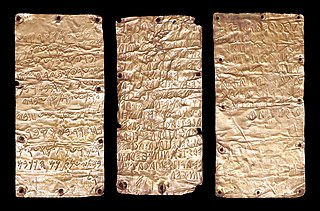
Baal, or Baʻal, was a title and honorific meaning 'owner' or 'lord' in the Northwest Semitic languages spoken in the Levant during antiquity. From its use among people, it came to be applied to gods. Scholars previously associated the theonym with solar cults and with a variety of unrelated patron deities, but inscriptions have shown that the name Ba'al was particularly associated with the storm and fertility god Hadad and his local manifestations.

The Pyrgi Tablets are three golden plates inscribed with a bilingual Phoenician–Etruscan dedicatory text. They are the oldest historical source documents from pre-Roman Italy and are rare examples of texts in these languages. They were discovered in 1964 during a series of excavations at the site of ancient Pyrgi, on the Tyrrhenian coast of Italy in Latium (Lazio). The text records the foundation of a temple and its dedication to the Phoenician goddess Astarte, who is identified with the Etruscan supreme goddess Uni in the Etruscan text. The temple's construction is attributed to Thefarie Velianas, ruler of the nearby city of Caere.
Phoenician is an extinct Canaanite Semitic language originally spoken in the region surrounding the cities of Tyre and Sidon. Extensive Tyro-Sidonian trade and commercial dominance led to Phoenician becoming a lingua franca of the maritime Mediterranean during the Iron Age. The Phoenician alphabet spread to Greece during this period, where it became the source of all modern European scripts.

Astarte is the Hellenized form of the Ancient Near Eastern goddess ʿAṯtart. ʿAṯtart was the Northwest Semitic equivalent of the East Semitic goddess Ishtar.

Umm Al Amad, or Umm el 'Amed or al Auamid or el-Awamid, is an Hellenistic period archaeological site near the town of Naqoura in Lebanon. It was discovered by Europeans in the 1770s, and was excavated in 1861. It is one of the most excavated archaeological sites in the Phoenician heartland.
The Thrones of Astarte are approximately a dozen ex-voto "cherubim" thrones found in ancient Phoenician temples in Lebanon, in particular in areas around Sidon, Tyre and Umm al-Amad. Many of the thrones are similarly styled, flanked by cherubim-headed winged lions on either side. Images of the thrones are found in Phoenician sites around the Mediterranean, including an ivory plaque from Tel Megiddo (Israel), a relief from Hadrumetum (Tunisia) and a scarab from Tharros (Italy).

The Umm Al-Amad votive inscription is an ex-voto Phoenician inscription of two lines. Discovered during Ernest Renan's Mission de Phénicie in 1860–61, it was the second-longest of the three inscriptions found at Umm al-Amad. All three inscriptions were found on the north side of the hill.
The Phoenician Adoration steles are a number of Phoenician and Punic steles depicting the adoration gesture (orans).

The Phoenician Sphinx inscription, also known as the Abdadoni inscription is an inscription found at Umm al-Amad, Lebanon.

The Phoenician sundial is a 2,000 year old scaphe sundial discovered in Umm al-Amad, Lebanon.

Phoenician votive inscriptions or Punic votive inscriptions are votive inscriptions in the Phoenician and Punic religion, dedicated to a certain god or gods, mostly on stelae. The inscriptions have a standard formula, including the name of the god, the statement of the vow, the name of the vower and a closing statement. Most of the inscriptions were found in Carthage, and dedicated to Tinnit, Baʿal Ḥammon or both.








